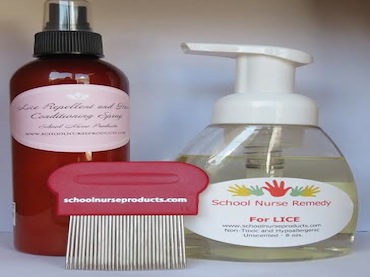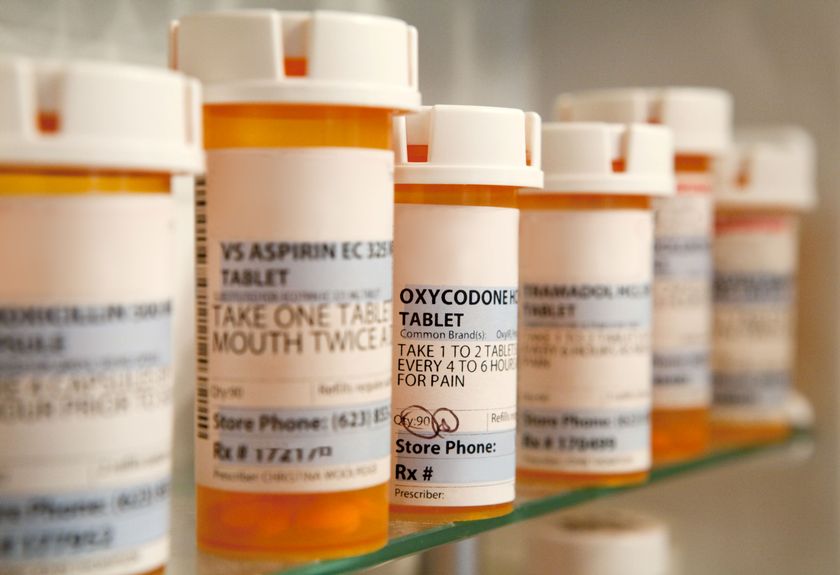- Sections :
- Crime & Public Safety
- Restaurants & Food
- Sports
- More
Categories
Treating head lice effectively and safer with non-toxic products

MONTGOMERY COUNTY, Texas --The Centers for Disease Control and Prevention (CDC) estimates that anywhere between 6 million and 12 million kids are infested each year in the U.S. with head lice. A few years ago, while working as a school nurse, I started doing research on the products that were being manufactured and used to treat head lice in children.
After a lot of research I decided to educate parents about the health hazards of using the most commonly used lice products on the market and decided to promote and sell safe products to help parents who are struggling with getting rid of head lice in their families. I started “School Nurse Products” which are non-toxic and contain no chemicals, and are safe products to use on a child’s head for head lice. Please read the information below about the dangers of some of the head lice products currently being sold and take the time to read about “School Nurse Products” because they are safer and more effective.
No one likes the idea of head lice, and the mention of head lice has us scratching our heads, but don’t run to the nearest store to buy just any lice-killing shampoo or medication. Lice shampoos typically contain toxic ingredients and chemicals that may cause your child harm. Marketers of these lice killing products may describe these products as safe but one study into insecticidal shampoos concluded that they may increase the risk of childhood leukemia. These products can be toxic or carcinogenic to your child, and may even be losing their effectiveness – this is because lice appear to have gradually become resistant to some of the chemicals found in these head lice killing products.
It’s scary to think that toxic chemicals are being used on the sensitive heads of our youth. Children are more susceptible to the dangers of head lice pesticides because the scalp has many blood vessels that are close to the skin, making it easy for toxic substances to be absorbed directly into the blood stream. Especially considering the fact that excessive scratching of the scalp is usually one of the first signs of having head lice, and this scratching results in breaking the skin allowing toxic chemicals to be absorbed. To make matters worse, children have a less mature immune system to protect them. It’s always a good idea to avoid subjecting your family to unnecessary chemicals and toxins in shampoos and lice-killing products.
It can be confusing to know what to buy when your child comes home with head lice. The FDA still endorses using Lindane (in Kwell) which is now banned by the EPA to use agriculturally. So it’s no wonder, with the FDA’s endorsement, parents continue to buy Lindane (in Kwell). Parents need to be aware of the fact that Lindane is banned in 18 foreign countries and The American Academy of Pediatrics does not recommend its use. The National Pediculosis Association, Inc. says that , “Lindane is a nerve poison that also causes cancer so why are we prescribing it for our children?” Their database has over 500 adverse event reports related to the use of lindane. Even worse, they say it can be unsafe even when used as directed. Children who have been treated repeatedly for head lice may be more at risk of adverse events with additional chemical exposures. Seizures, behavioral changes, attention deficit disorders, cancer, skin disease and even death have been reported to the NPA’s registry.
Pryrethrins and pyrethrums (found in Rid, Nix, Pronto, and possibly other lice treatments) are pesticides made from flowers (a type of chrysanthemum). Synthetic pyrethroids (permethrins) are chemical imitations of these natural products. Synergists are chemicals added to increase their killing power. Any pesticide can theoretically cause allergic reactions, although some are more likely than others. Products made from a member in this family of pesticides are likely to precipitate allergic reactions, particularly for people with allergies, asthma or chemical sensitivities. One reason is that they cross-react with ragweed and other plant pollens. In Designer Poisons, Marion Moses, MD suggests that these types of pesticides attack the brain and nervous system. Permethrin is a neurotoxin, a carcinogen (as stated by the U.S. Environmental Protection Agency), and can cause tremors, increased aggressive behavior, high body temperature and learning difficulties. It causes major irritation of the skin and eyes, swelling and rashes, numbness, fluid in the lungs, and even infertility.
Malathion is an organophosphate insecticide and its use has produced side effects such as intestinal disorders, leukemia, kidney damage, birth defects, brain damage, weakening of the immune system, lung damage and many others. Just inhaling this chemical can result in dizziness, pupillary constriction, muscle cramps, excessive salivation, sweating, labored breathing and unconsciousness.
The ingredient, Acetone, can cause wheezing, congestion, headache, fatigue, hyperactivity, confusion, dizziness and eye, throat and nose irritation, liver, kidney and skin damage and birth defects. Symptoms include nausea, slurred speech and drowsiness. The EPA considers it a hazardous waste.
Both Benzyl Alcohol and Isopropyl Alcohol can be flammable and cause allergies, intestinal damage and vomiting. They have also been found to irritate the nose, throat and lungs, dull the nervous system and can cause death in severe cases due to respiratory failure.
The synergist, Piperonyl Butoxide, is an active ingredient in many of the pyrethrin pesticide family head lice products. Two recent reports in open literature show that it causes cancer and birth defects in rats. ANY PRODUCT which contains this ingredient, should never be recommended for use in children.
“Inert ingredients” are added to pesticides to dissolve, emulsify or stabilize them or to facilitate the spreading, sticking and penetration of the pesticides. Often, some of these “inerts” are AS DANGEROUS AS THE PESTICIDES.
There are many other health conditions, as well as genetics, that predispose a person to more serious health problems if they become exposed to pesticides. It’s just not worth the risk to you or your family to use toxic pesticides when you can take care of getting rid of lice in a safe manner by using School Nurse Products.
School Nurse Products currently has three products available: “SCHOOL NURSE Remedy for Lice” which uses biodegradable, natural, organic materials that destroys the protective exoskeleton which head lice need in order to survive. Because it does not use chemicals or pesticides in the product to get rid of head lice, they can never build up a “resistance” to this product. This product also loosens the “glue” that keeps the nits cemented to the hair shaft so you can easily comb the nits out. The“School Nurse Lice Comb” has been lab tested to be 100% effective, and there’s nothing better than 100% effective. Also available is the “School Nurse Lice Repellent and Hair Conditioning Spray” which repels lice due to the safe ingredients in the product. This product can be used after each shampoo and it doesn’t stop working until you wash it out. It can also be used to “wet-comb” out nits. Read more about this and more about our products on the website link provided.
Don’t wait till your child comes home with head lice. Have the products on hand and be prepared to treat your family safely, if and when you need to treat them for head lice. The products are currently available at the website provided.
After a lot of research I decided to educate parents about the health hazards of using the most commonly used lice products on the market and decided to promote and sell safe products to help parents who are struggling with getting rid of head lice in their families. I started “School Nurse Products” which are non-toxic and contain no chemicals, and are safe products to use on a child’s head for head lice. Please read the information below about the dangers of some of the head lice products currently being sold and take the time to read about “School Nurse Products” because they are safer and more effective.
No one likes the idea of head lice, and the mention of head lice has us scratching our heads, but don’t run to the nearest store to buy just any lice-killing shampoo or medication. Lice shampoos typically contain toxic ingredients and chemicals that may cause your child harm. Marketers of these lice killing products may describe these products as safe but one study into insecticidal shampoos concluded that they may increase the risk of childhood leukemia. These products can be toxic or carcinogenic to your child, and may even be losing their effectiveness – this is because lice appear to have gradually become resistant to some of the chemicals found in these head lice killing products.
It’s scary to think that toxic chemicals are being used on the sensitive heads of our youth. Children are more susceptible to the dangers of head lice pesticides because the scalp has many blood vessels that are close to the skin, making it easy for toxic substances to be absorbed directly into the blood stream. Especially considering the fact that excessive scratching of the scalp is usually one of the first signs of having head lice, and this scratching results in breaking the skin allowing toxic chemicals to be absorbed. To make matters worse, children have a less mature immune system to protect them. It’s always a good idea to avoid subjecting your family to unnecessary chemicals and toxins in shampoos and lice-killing products.
It can be confusing to know what to buy when your child comes home with head lice. The FDA still endorses using Lindane (in Kwell) which is now banned by the EPA to use agriculturally. So it’s no wonder, with the FDA’s endorsement, parents continue to buy Lindane (in Kwell). Parents need to be aware of the fact that Lindane is banned in 18 foreign countries and The American Academy of Pediatrics does not recommend its use. The National Pediculosis Association, Inc. says that , “Lindane is a nerve poison that also causes cancer so why are we prescribing it for our children?” Their database has over 500 adverse event reports related to the use of lindane. Even worse, they say it can be unsafe even when used as directed. Children who have been treated repeatedly for head lice may be more at risk of adverse events with additional chemical exposures. Seizures, behavioral changes, attention deficit disorders, cancer, skin disease and even death have been reported to the NPA’s registry.
Pryrethrins and pyrethrums (found in Rid, Nix, Pronto, and possibly other lice treatments) are pesticides made from flowers (a type of chrysanthemum). Synthetic pyrethroids (permethrins) are chemical imitations of these natural products. Synergists are chemicals added to increase their killing power. Any pesticide can theoretically cause allergic reactions, although some are more likely than others. Products made from a member in this family of pesticides are likely to precipitate allergic reactions, particularly for people with allergies, asthma or chemical sensitivities. One reason is that they cross-react with ragweed and other plant pollens. In Designer Poisons, Marion Moses, MD suggests that these types of pesticides attack the brain and nervous system. Permethrin is a neurotoxin, a carcinogen (as stated by the U.S. Environmental Protection Agency), and can cause tremors, increased aggressive behavior, high body temperature and learning difficulties. It causes major irritation of the skin and eyes, swelling and rashes, numbness, fluid in the lungs, and even infertility.
Malathion is an organophosphate insecticide and its use has produced side effects such as intestinal disorders, leukemia, kidney damage, birth defects, brain damage, weakening of the immune system, lung damage and many others. Just inhaling this chemical can result in dizziness, pupillary constriction, muscle cramps, excessive salivation, sweating, labored breathing and unconsciousness.
The ingredient, Acetone, can cause wheezing, congestion, headache, fatigue, hyperactivity, confusion, dizziness and eye, throat and nose irritation, liver, kidney and skin damage and birth defects. Symptoms include nausea, slurred speech and drowsiness. The EPA considers it a hazardous waste.
Both Benzyl Alcohol and Isopropyl Alcohol can be flammable and cause allergies, intestinal damage and vomiting. They have also been found to irritate the nose, throat and lungs, dull the nervous system and can cause death in severe cases due to respiratory failure.
The synergist, Piperonyl Butoxide, is an active ingredient in many of the pyrethrin pesticide family head lice products. Two recent reports in open literature show that it causes cancer and birth defects in rats. ANY PRODUCT which contains this ingredient, should never be recommended for use in children.
“Inert ingredients” are added to pesticides to dissolve, emulsify or stabilize them or to facilitate the spreading, sticking and penetration of the pesticides. Often, some of these “inerts” are AS DANGEROUS AS THE PESTICIDES.
There are many other health conditions, as well as genetics, that predispose a person to more serious health problems if they become exposed to pesticides. It’s just not worth the risk to you or your family to use toxic pesticides when you can take care of getting rid of lice in a safe manner by using School Nurse Products.
School Nurse Products currently has three products available: “SCHOOL NURSE Remedy for Lice” which uses biodegradable, natural, organic materials that destroys the protective exoskeleton which head lice need in order to survive. Because it does not use chemicals or pesticides in the product to get rid of head lice, they can never build up a “resistance” to this product. This product also loosens the “glue” that keeps the nits cemented to the hair shaft so you can easily comb the nits out. The“School Nurse Lice Comb” has been lab tested to be 100% effective, and there’s nothing better than 100% effective. Also available is the “School Nurse Lice Repellent and Hair Conditioning Spray” which repels lice due to the safe ingredients in the product. This product can be used after each shampoo and it doesn’t stop working until you wash it out. It can also be used to “wet-comb” out nits. Read more about this and more about our products on the website link provided.
Don’t wait till your child comes home with head lice. Have the products on hand and be prepared to treat your family safely, if and when you need to treat them for head lice. The products are currently available at the website provided.
Comments •

















